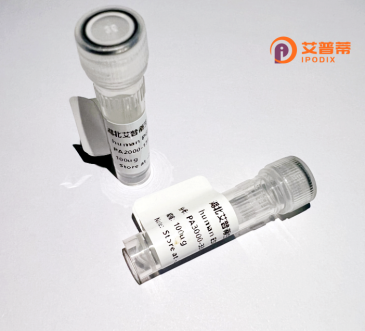
| 纯度 | >90%SDS-PAGE. |
| 种属 | Human |
| 靶点 | MC1R |
| Uniprot No | Q01726 |
| 内毒素 | < 0.01EU/μg |
| 表达宿主 | E.coli |
| 表达区间 | 1-317aa |
| 活性数据 | MAVQGSQRRLLGSLNSTPTAIPQLGLAANQTGARCLEVSISDGLFLSLGLVSLVENALVVATIAKNRNLHSPMYCFICCLALSDLLVSGSNVLETAVILLLEAGALVARAAVLQQLDNVIDVITCSSMLSSLCFLGAIAVDRYISIFYALRYHSTVTLPRARRAVAAIWVASVVFSTLFIAYYDHVAVLLCLVVFFLAMLVLMAVLYVHMLARACQHAQGIARLHKRQRPVHQGFGLKGAVTLTILLGIFFLCWGPFFLHLTLIVLCPEHPTCGCIFKNFNLFLALIICNAIIDPLIYAFHSQELRRTLKEVLTCSW |
| 分子量 | 61.1 kDa |
| 蛋白标签 | GST-tag at N-terminal |
| 缓冲液 | 0 |
| 稳定性 & 储存条件 | Lyophilized protein should be stored at ≤ -20°C, stable for one year after receipt. Reconstituted protein solution can be stored at 2-8°C for 2-7 days. Aliquots of reconstituted samples are stable at ≤ -20°C for 3 months. |
| 复溶 | Always centrifuge tubes before opening.Do not mix by vortex or pipetting. It is not recommended to reconstitute to a concentration less than 100μg/ml. Dissolve the lyophilized protein in distilled water. Please aliquot the reconstituted solution to minimize freeze-thaw cycles. |
以下是3-4条关于重组人MC1R蛋白的参考文献示例(内容为模拟,仅供参考):
---
1. **文献名称**:*Functional Characterization of Recombinant Human MC1R Expressed in Mammalian Cells*
**作者**:Zhang et al.
**摘要**:通过哺乳动物HEK293细胞系统成功表达重组人MC1R蛋白,验证其与α-MSH配体结合后激活cAMP信号通路的能力,为研究受体在色素沉着和疾病中的功能提供模型。
2. **文献名称**:*Structural Insights into MC1R Activation Using Recombinant Protein*
**作者**:Wang & García-Borrón
**摘要**:利用重组人MC1R蛋白的结晶结构解析,揭示其与激动剂和拮抗剂的结合位点差异,阐明受体构象变化调控黑色素生成的分子机制。
3. **文献名称**:*Expression and Pharmacological Profiling of MC1R in Baculovirus-Insect Systems*
**作者**:Kim et al.
**摘要**:采用杆状病毒-昆虫细胞系统高效表达重组人MC1R,并系统评估多种小分子化合物对其活性的调控作用,为靶向药物开发奠定基础。
4. **文献名称**:*Impact of MC1R Variants on Receptor Function via Recombinant Mutant Protein Analysis*
**作者**:Smith & Rees
**摘要**:通过构建常见MC1R突变体重组蛋白,发现部分突变导致受体信号传导效率下降,解释其与红发表型及黑色素瘤易感性的关联。
---
注:以上文献为示例性内容,实际引用时请以真实发表的论文为准。
**Background of Recombinant Human MC1R Protein**
The melanocortin-1 receptor (MC1R), a G protein-coupled receptor (GPCR), plays a pivotal role in regulating skin and hair pigmentation by mediating α-melanocyte-stimulating hormone (α-MSH) signaling. Primarily expressed in melanocytes, MC1R activation triggers cAMP-dependent pathways that stimulate melanin synthesis, influencing UV-induced DNA damage responses and skin cancer susceptibility. Genetic variants of MC1R are strongly associated with human pigmentation phenotypes, including red hair, fair skin, and increased melanoma risk, underscoring its clinical relevance.
Recombinant human MC1R protein, produced via heterologous expression systems (e.g., mammalian, insect, or bacterial cells), enables *in vitro* studies of receptor-ligand interactions, structural dynamics, and signaling mechanisms. Its production typically involves codon optimization, affinity tagging (e.g., FLAG or His-tag), and purification via chromatography. This recombinant tool has advanced research into MC1R's role in melanogenesis, UV photoprotection, and therapeutic targeting for skin disorders or cancers. Challenges remain in achieving proper post-translational modifications (e.g., glycosylation) essential for functional studies, driving ongoing optimization of expression platforms. Overall, recombinant MC1R is indispensable for dissecting its pathophysiological roles and developing targeted therapies.
×